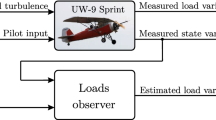Abstract
A takeoff-monitoring algorithm is proposed that allows predicting the rate of an aircraft takeoff run and recognizing emergency situations that require reject the takeoff. The algorithm is based on combined use of a polynomial approximation of the dependence of the takeoff speed on time and the CUSUM test to detect abrupt changes in the dynamics of the aircraft. Mathematical modeling of the algorithm is presented using a model of a lightweight aircraft.












Similar content being viewed by others
Change history
09 November 2020
The TeX presentation of formulas was updated in HTML file.
03 December 2020
An Erratum to this paper has been published: https://doi.org/10.3103/S1068799820030289
REFERENCES
Aviatsionnye pravila. Ch. 25. Normy letnoi godnosti samoletov transportnoi kategorii (Federal Aviation Regulations. Part 25. Airworthiness Standards: Transport Category Airplanes), Moscow: Aviaizdat, 2015.
Xu, J., Overview of Certification of Aeroplane Takeoff and Landing Performance on Contaminated Runways, Proc. of the 2nd International Symposium on Aircraft Airworthiness, 2011, Beijing, vol. 17, pp. 13–23.
Brown, A.P. and Abbasi, H., Takeoff Performance Monitoring Systems, Technology, Certificatability and Operability Status, URL: https://nrc-publications.canada.ca/eng/view/fulltext/?id=0fa746bc-edb1-46f9-aa83-af93ee3b2d49.
Aerospace Standard AS-8044. Takeoff Performance Monitor (TOPM) System, Airplane, Minimum Performance Standard for, URL: https://saemobilus.sae.org/content/AS8044.
Glubokaya, M.G., The Current State of Solving the Take-Off Safety Problem, Iskusstvennyi Intellekt, 2005, no. 3, pp. 370–380.
Glubokaya, M.G., Method of Take-Off Monitoring by Means of Effective Take-Off Mass Function, Uchenye Zapiski TsAGI, 2009, vol. 40, no. 1, pp. 82–91 [TsAGI Science Journal (Engl. Transl.), vol. 40, no. 1, pp. 117–129].
Shevchenko, A.M., Pavlov, B.V., and Nachinkina, G.N., Method of Aircraft Takeoff Forecasting in the Presence of High-Altitude Obstacles, Izv. YuFU. Tekhnicheskie Nauki, 2012, no. 3 (128), pp. 167–172.
Zammit-Mangion, D., Design and Development of an Algorithm for a Take-off Performance Monitor, Cranfield: Cranfield University, 2001.
Brown, R.L., Durbin, J., and Evans, J.M., Techniques for Testing the Constancy of Regression Relationships over Time, Journal of the Royal Statistical Society, Series B, 1975, vol. 37, no. 2, pp. 149–192.
Kotik, M.G., Dinamika vzleta i posadki samoletov (Dynamics of Aircraft Takeoff and Landing), Moscow: Mashinostroenie, 1984.
Efremov, A.V., Tyaglik, M.S., Irgaleev, I.Kh., and Gorbatenko, S.A., Predictive Information Design for the Novel Generation of Display for the Highly-Augmented Aircraft, Izv. Vuz. Av. Tekhnika, 2017, vol. 60, no. 2, pp. 87–92 [Russian Aeronautics (Engl. Transl.), vol. 60, no. 2, pp. 257–262].
ACKNOWLEDGEMENTS
This work was supported by the Russian Foundation for Basic Research grant no. 18-08-01045.
Author information
Authors and Affiliations
Corresponding author
About this article
Cite this article
Garkushenko, V.I., Lazareva, P.A. Takeoff Monitoring Algorithm with Prediction. Russ. Aeronaut. 63, 222–229 (2020). https://doi.org/10.3103/S1068799820020063
Received:
Revised:
Accepted:
Published:
Issue Date:
DOI: https://doi.org/10.3103/S1068799820020063




